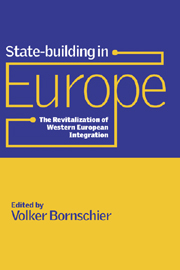Book contents
- Frontmatter
- Contents
- List of figures and tables
- List of contributors
- Preface
- Acknowledgements
- Part I State-building and Political Entrepreneurship
- Part II The Core Elements in Recasting the European Bargain
- Part III Conclusions beyond the Single European Act of 1986
- 7 Lobbying for a Europe of big business: the European Roundtable of Industrialists
- 8 Biotechnology in the European Union: a case study of political entrepreneurship
- 9 European integration after the Single Act: changing and persisting patterns
- 10 The state of the European Union
- Appendix List of interview partners
- Bibliography
- Index
10 - The state of the European Union
Published online by Cambridge University Press: 10 October 2009
- Frontmatter
- Contents
- List of figures and tables
- List of contributors
- Preface
- Acknowledgements
- Part I State-building and Political Entrepreneurship
- Part II The Core Elements in Recasting the European Bargain
- Part III Conclusions beyond the Single European Act of 1986
- 7 Lobbying for a Europe of big business: the European Roundtable of Industrialists
- 8 Biotechnology in the European Union: a case study of political entrepreneurship
- 9 European integration after the Single Act: changing and persisting patterns
- 10 The state of the European Union
- Appendix List of interview partners
- Bibliography
- Index
Summary
What kind of state?
Having reassessed the integration thrust of the 1980s and the events that it set in motion, we have summarized our findings on the structure of the policy areas that set the tone of the political economy of the Union. We would now like to comment on the form of state that developed out of this process. The curious nature of this state is widely acknowledged by scholars; we would like to add that the puzzling nature of the governance structures embodied in the institutions of the European Union is due to a renewed compromise between two old European processes – nationalism and liberalism.
What exactly is ‘odd’ about the form of state called the European Union?
The European Union, which evolved from the renewed drive for European integration in the mid-1980s and which officially assumed this new name through the Treaty on European Union (agreed to at the end of 1991 and in effect since the completion of its ratification in 1993), is something new in the recent history of European state-building. This new form of state remains, as we termed it in chapter 1, a somewhat strange hermaphrodite – something between a confederation of states and a federal state. One important difference between the two is that a federal state unites several states within the framework of a single state in a single nation and is the exclusive subject of international law. By contrast, a confederation of states does not constitute a subject of international law on its own (Scholz 1995: 116f).
- Type
- Chapter
- Information
- State-building in EuropeThe Revitalization of Western European Integration, pp. 264 - 284Publisher: Cambridge University PressPrint publication year: 2000
- 1
- Cited by

